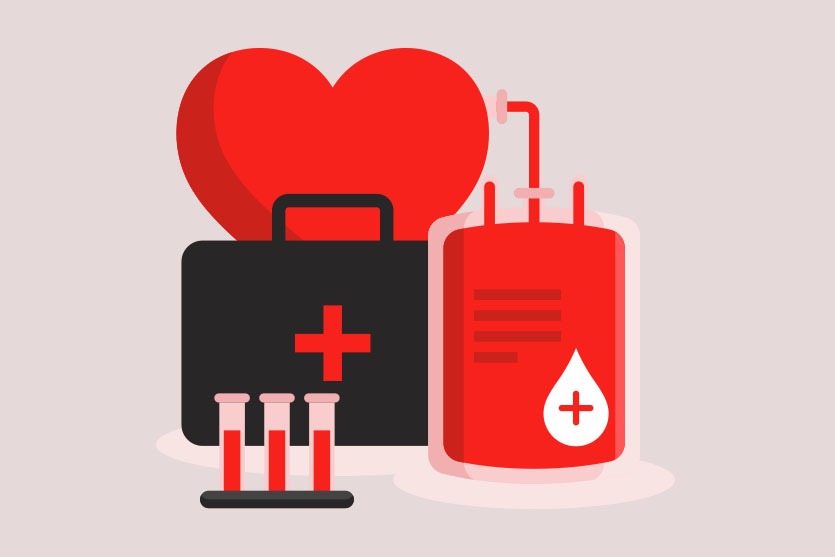
Benefits of Blood Donation and Its Positive Impact on Society
Introduction
Many people fear donating blood for various reasons. Some fear needle pricks, while others dislike seeing the red color of blood. Additionally, there are those who fear losing too much blood or fainting. However, blood donation holds numerous health benefits that positively impact the donor’s overall health and the general public’s well-being.
Blood donation is a medical procedure involving the voluntary transfer of blood from a healthy individual to a sick person in need of blood. This blood is used either in whole or after separating its components through a process called fractionation.
An adult human body contains approximately 5 liters of blood, out of which only 450 milliliters are donated. This constitutes only 8% of an average adult’s blood volume, meaning that blood donation does not significantly affect the donor’s regular activities. The body rapidly replenishes the donated blood within a few hours, and red blood cells are replaced within a few days. This process does not require following a specific dietary regimen.
Benefits of Blood Donation
1.Prevention of Cardiovascular Diseases
- Cardiovascular diseases rank as the leading cause of death worldwide, including in scientifically and medically advanced countries. Excessive iron in the blood is believed to play a role in causing cardiovascular diseases by potentially leading to the accumulation of fatty deposits in the arteries, increasing the risk of heart attacks and strokes.
- Men are more susceptible to cardiovascular diseases as women generally have lower iron levels in their blood during childbearing years. Men lose iron through blood donation, which helps in reducing iron accumulation in the body.
- Regular blood donation has shown to reduce the risk of cardiovascular diseases in men. Studies indicate that men who donate blood at least once a year were 30% less likely to develop cardiovascular diseases compared to those who did not donate blood.
2.Renewal of Red Blood Cells
- During each blood donation, approximately 450 milliliters of blood, roughly 8% of an adult’s blood volume, can be donated. This loss triggers the beginning of bone renewal.
- Plasma, the liquid part of the blood, returns to the body within 24 hours. Red blood cells, responsible for transporting oxygen throughout the body, take around 4 to 6 weeks to be reproduced.
- The average lifespan of red blood cells is about 115 days. Through blood donation, older red blood cells are replaced, prompting the body to produce new red blood cells, ultimately restoring the blood to its optimal levels.
3.Improving Blood Flow
There are several factors that can increase blood density in the body, including:
- Birth control pills
- Estrogen hormone: Taking estrogen hormone, such as hormone replacement therapy, can elevate protein levels in the blood, leading to increased blood density.
- Bed rest or inactivity: Prolonged periods of inactivity or bed rest can elevate protein levels in the blood, resulting in increased blood density.
- Infections: Infections can raise protein levels in the blood, contributing to increased blood density.
- Diabetes: Elevated blood sugar levels can increase protein levels in the blood, leading to increased blood density.
- Obesity: Weight gain can elevate protein levels in the blood, resulting in increased blood density.
- Cancer: Cancer can raise protein levels in the blood, contributing to increased blood density.
- Aging: Advancing age can elevate protein levels in the blood, leading to increased blood density.
During blood donation, about 450 milliliters of blood, approximately 8% of an adult’s blood volume, is removed.
This leads to a decrease in blood density. Plasma returns to its normal state within 24 hours, while red blood cells take 4 to 6 weeks to replenish.
4.Reducing Harmful Iron Stores
Iron is a vital mineral for the body, aiding in the transportation of oxygen to cells. However, excessive iron can be detrimental, causing issues with the heart, liver, and diabetes.
Those most at risk of excessive iron include:
- Vegetarians: Not obtaining iron from meat or fish, vegetarians may need to take iron supplements.
- Women: Women lose iron during menstruation, so they may need to consume more iron to maintain normal levels.
- Individuals with certain conditions such as sickle cell anemia or hemochromatosis.
- Gym enthusiasts taking supplements.
How to protect yourself from excessive iron:
- If taking iron supplements, adhere strictly to your doctor’s guidance.
- If using medications containing iron, discuss the risks of excessive iron with your doctor.
- If at risk of excessive iron, consult your doctor on how to reduce your iron levels.
- Blood donation can serve as a method to eliminate excess iron.
Conclusion:
In conclusion, understanding the complexities of blood density and iron levels within the body unveils a spectrum of factors that influence our health. The dynamics of blood flow, influenced by various elements like hormonal balance, inactivity, illnesses, and lifestyle choices, illustrate the delicate equilibrium our bodies strive to maintain.
Furthermore, the significance of maintaining optimal iron levels cannot be overstated. While iron is essential for oxygen transport, excessive amounts can lead to detrimental health implications. Recognizing the at-risk groups and adopting preventive measures, such as regulated supplementation and blood donation, emerges as pivotal strategies in safeguarding against iron-related complications.
Ultimately, these insights shed light on the intricate interplay between our choices, bodily functions, and overall well-being. By acknowledging and addressing these factors, we pave the way for a more informed and proactive approach to maintaining a healthier, balanced lifestyle.









Bobby3621
April 12, 2025https://vitz.ru/forums/index.php?autocom=gallery&req=si&img=4698
Coraline4979
April 19, 2025http://wish-club.ru/forums/index.php?autocom=gallery&req=si&img=5305
Dalton990
April 20, 2025Very good https://is.gd/tpjNyL
Irma1709
April 22, 2025Awesome https://is.gd/tpjNyL
Neal982
April 23, 2025Good https://is.gd/tpjNyL
Freddie4326
April 25, 2025Very good https://lc.cx/xjXBQT
Randall2351
April 27, 2025Very good https://t.ly/tndaA
Simon61
April 27, 2025Awesome https://urlr.me/zH3wE5
Cindy4209
April 28, 2025Good https://rb.gy/4gq2o4
Krystal1865
April 28, 2025Awesome https://is.gd/N1ikS2
Dorian4596
April 28, 2025Very good https://is.gd/N1ikS2
Alejandro172
April 29, 2025Good https://is.gd/N1ikS2
Bob921
April 30, 2025Awesome https://is.gd/N1ikS2
Autumn414
May 1, 2025Good https://is.gd/N1ikS2
Kristina90
May 1, 2025Very good https://is.gd/N1ikS2
Pat886
May 4, 2025https://hrv-club.ru/forums/index.php?autocom=gallery&req=si&img=7149
Melody1211
May 4, 2025https://hrv-club.ru/forums/index.php?autocom=gallery&req=si&img=7147
Parker678
May 6, 2025https://myteana.ru/forums/index.php?autocom=gallery&req=si&img=6890
Eugene4728
May 6, 2025http://terios2.ru/forums/index.php?autocom=gallery&req=si&img=4853
Freddie4527
May 7, 2025http://terios2.ru/forums/index.php?autocom=gallery&req=si&img=4758
Max1346
May 7, 2025https://honda-fit.ru/forums/index.php?autocom=gallery&req=si&img=7236